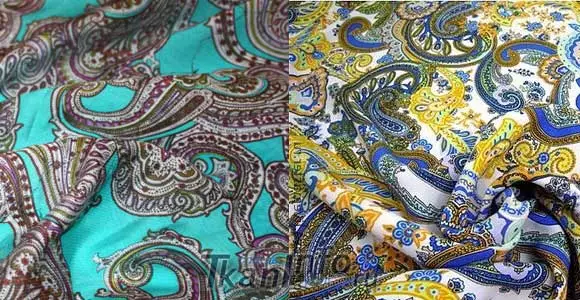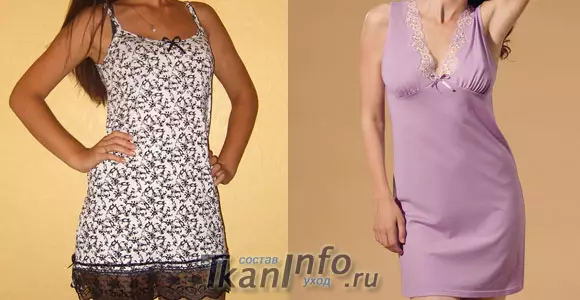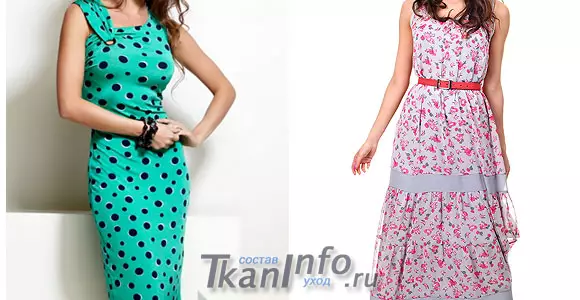Up to the beginning of last century, only natural fabric was used for clothing, for which fibers of plant or animal origin were used. Over the course of several centuries, attempts were made to find them a replacement, and some success in this area were achieved at the end of the XIX century. The first patent for the fiber obtained from the treated cellulose was issued in 1884 by the Frenchman De Shardonne, and the first viscose fabric was obtained in England in 1893.
Since then, artificial fibers have received extremely widespread use. Although the raw materials for their preparation still serves cellulose, the properties of the tissue obtained from such raw materials, as well as its appearance and purpose may be the most diverse.

Receipt and varieties
In order to deal with what the viscose is that the fabric is made on its basis and what it may be its characteristics, it is necessary to understand that it is a rather extensive mass of artificial materials. Unlike natural fibers, directly obtained from animals or plants, or synthetic materials, which are obtained by synthesizing oil and gas processing products, the composition of the viscose is cellulose treated with one or another type of solvent, and modified as a filament or film (cellophane).
Its name occurring from the Latin word "sticky", this material received due to the viscosity of the substance, from which its fibers are formed. The most common is the dissolution method by caustic scholars of crushed wood or cotton products, as a result of which can be obtained both thin shiny threads resembling silk and fluffy fiber woolen texture. Regardless of the method of obtaining a cellulosic solution, the production of viscose is carried out in such a sequence:
- purification, grinding and pre-processing of raw materials;
- dissolving and removal of excess liquid;
- Purpose of the viscose mass through filters and the formation of fibers;
- their subsequent processing (drying, pressing, bleaching, painting, etc.).
Article on the topic: Stencils for point painting for beginner bottles and caskets
The resulting threads can be textile, technical or staple.
- From thin and not particularly durable textile fibers, various fabrics and viscose knitwear are manufactured, they are also used as an additive to other fibers when creating mixtures.
- Large and durable technical threads are used for the manufacture of cord materials.
- A special category is a staple fiber that has a small length. Staple fabrics, artificial fur, non-woven materials are manufactured from it.
- Last demand has recently used viscose for felting, which is characterized by special softness and ease of operation.

The classification of artificial fabrics can be conducted according to the features of their preparation, methods for processing fibers, as well as the composition of raw materials. Among the many varieties of artificial materials can be allocated as:
- acetate (triacetate) silk, which is distinguished by glitter, fastens little and is quite shapeless;
- Collusion - Staple fiber, with a structure resembling wool, is used as its substitute;
- The dumpier is an elite fabric based on copper-ammonia fibers, the properties of which are approaching natural silk;
- Modal - improved viscose based on eucalyptus, pine or beech, refers to environmentally friendly materials;
- The tensel (lio-cell) - the eucalyptic cellulose fabric, processed by innovative technologies, is distinguished by the strength and antiseptic properties;
- The satel - improved viscose based on coniferous wood;
- Polinky materials - viscose materials with a homogeneous structure of fibers, are characterized by increased strength and elasticity;
- Bamboo - material based on bamboo cellulose, which is closest in its properties closest to natural cotton, often the cellulosic mass for it is obtained without the use of potent chemicals by mechanical crushing and natural fermentation (the so-called bamboo flax).

Properties of artificial materials
The viscose fabrics can resemble any natural material from the thinnest silk to the fur, besides, they are very hygienic, pleasant to the touch, do not cause skin irritation, capable of adjusting the temperature at the body surface, unlike most species of synthetics . The main advantages of all types of viscose are:- Softness and pleasant tactile sensations;
- High hygroscopicity;
- air permeability;
- "Warming" properties;
- durability;
- variety of textures;
- lack of electrification;
- low price (for most varieties);
- Ease of recycling.
Article on the topic: Girl jacket with knitting needles: knitting pattern
However, this material has significant disadvantages. First of all, it is not too durable and does not differ in wet strength, quickly loses its appearance when exposed to ultraviolet. All artificial materials are strong and distinguished by high margins. It should also be noted that positive properties often turnpit and disadvantages: so, good hygroscopicity leads to unwanted moisture absorption, and some varieties of such tissues, such as bamboo, can be molded in a humid atmosphere. Excessive softness leads to the fact that these products are poorly held by the form, and without special processing on them cannot be created folds and assemblies.
To the question, whether the viscose sits down, the unambiguous answer to give it difficult. Fabrics that are produced by traditional technology can give a strong shrinkage. Upgraded materials are available with special processing, which prevents shrinkage and makes the canvas formed. It is also difficult to give a response, viscose stretches or not. Knitted, the viscose knitwear is very elastic, and in order for the property to have purchased woven fabrics, they need to add elastane. Thus, in order to avoid unwanted clothing characteristics, you need to carefully examine the composition of the fabric. Most often, the viscose content does not exceed 30%, in this case its unwanted properties are practically not manifested.
Application and care
Most buyers do not know that artificial materials are widely used as packaging, in the production of artificial leather and technical tissues. It should be noted that both clean viscose clothing, and the viscose knitwear are currently occurring much less often than half a century ago. Basically, such material is used in mass Indian textiles, it is often used as lining, for inexpensive accessories. This does not concern such modern materials like bamboo, modal, tensel, etc. They are often used for sewing a variety of clothes, linen, bed kits. The absorption properties of the viscose canvas make it very popular towels, bath accessories, cleaning accessories.
Article on the topic: Crochet slippers: Video lessons for beginners with schemes
Buying a product from artificial fibers, you need to carefully familiarize yourself with the rules of the departure indicated on the label. If there is no such description, then general rules, how to wash the viscose, such:
- Washing - only manual or gentle mode at a temperature of 30 degrees;
- neutral detergents without bleach;
- The spin is produced on small circulation, with manual wash slightly press water without twisting or rolled into a towel;
- products, especially viscose knitwear, dried in a horizontal position away from sunlight and heat sources;
- Ironing is produced in the "Silk" mode, without spaling and without splashing with water.
